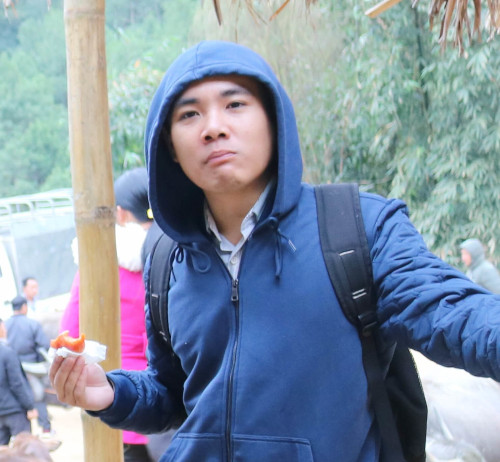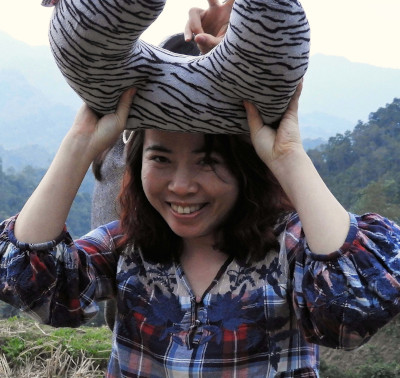
Thinking about water buffalo: A visit to the Cong Bang Market of Bac Kan Province in the north of Vietnam
When I was around 4 years old, my parents bought a water buffalo. My job was to take care of her, and I loved watching how she changed with age. I would take her into the fields to feed her at this area of grass she liked between two wet rice paddy fields. When I got lazy, I would ride her around until she tried to throw me. Our buffalo was trained not to eat rice (but she still did), and she could understand Vietnamese words like đi = go, bặt = turn right, and diệt = turn left . She was also sometimes a really naughty buffalo. She hated work so whenever she saw our plough, she simply ran away. Farmers know that naughty buffalo are a real pain, as it is really tiring trying to get the necessary work done. But you see, I think there is something more. I know that buffalo understand human feelings. As a child, when I was upset and crying and ran away from my parents for whatever reason, I always came to our buffalo for support. I would pet her and tell her my story. At these times, she would never be naughty, and just slowly ate grass while listening to my stories. I used to catch insects and cook rice soup for her when she got tired. In the evenings, she would eat rice straw, and my mother sometimes added salt water to her meal to improve the flavor. In the field (where she knew I would give her some food), she would turn around like a pet dog when I approached. We considered our buffalo as a member of the family. There were also some emotional times. I remember how our buffalo cried when we sold her baby. I also remember when my mom decided it was time for her to be sold. I was so sad. My mom says that animals are sensitive to the smell of blood on people who work in a slaughterhouse. When our buffalo smelled the buyer, I swear I saw that she was crying. She knew what was going to happen. After she left, whenever I saw her empty stall, I always felt sad. These days, when I see water buffalo in the fields, it reminds me of my childhood and happy times. I think children today no longer care about buffalo like in previous generations. They spend too much time studying and playing video games. Buffalo meat is also now more popular in the market, and people are forgetting our previous working and personal relationships with this animal. Tractors now do the work, and buffalo are simply raised in pens for profit. It really saddens me.
Introduction
Vietnam is industrializing quickly, and the north of the country is no exception. On the flatter lands in the comparatively wealthier farming communities around the capital of Hanoi, the gasoline powered tractor has largely replaced the labor of the buffalo. As the population demands more meat in their diet, water buffalo are now raised for consumption, often in pens, rather than for power to pull ploughs. In these areas, children no longer grow up with closer personal relationships with these animals.
As a research team, we have considerable respect for the complex social, cultural, and economic histories the different people in the north of the country have with water buffalos. Indeed, since 2016, we have been collecting stories such as that in the introduction to interpret how economic development is affecting these human-animal relationships.
So, sitting at our stuffy academic desks in the provincial capital of Thai Nguyen City reviewing interview transcripts one rainy December afternoon in 2018, the research team realized it needed a dose of positivity and a mental re-boot. It was time to reconnect to the places where the buffalo are still profoundly entrenched in the daily lives of the people. It was time again to head to the mountainous regions further north. Bac Kan Province is located in the mountainous region in the north of Vietnam. Approximately 87% of its 308,900 inhabitants are members of an ethnic minority, including the Tày (54%), Dao (17%), Nung (9%), and H’mong (5.5%) groups. In 2014, the per capita income in the province was estimated at US $1,120, meaning it one of the most impoverished areas in the country (Department of Labour, Invalids and Social Affairs, 2015).
We decided to focus on Cong Bang Market, in the Pak Nam District of Bac Kan Province. There are few things inherently more geographical than the dynamics present in a farmers’ market, and we knew this one specializes in the sale of water buffalo. We took a list of local contacts, the best cameras we could find, and a DJI Phantom 4 sUAV (i.e., drone). While visiting old friends, building new research networks, and conducting interviews for our larger project, we strove to document a day at the market.
December in Bac Kan Province. The rice harvest is over and the usual lush bright greens have given way to more somber ambers. December is in the dry season (which lasts from November to April). Climate change is extending the length and severity of this season which is resulting in drought conditions that stress animal and agricultural production. Crop failures and disease outbreaks in livestock continue to hamper economic development.
The Market
This market was founded in 1990 through government policies seeking to develop the local and regional economies. Prior to its establishment, residents needed to travel on unpaved roads over 40 km to purchase necessities such as salt and oil. The road was improved in 2004. The market schedule is organized on the lunar calendar, and operates five to six times a month.
The research team woke early and headed straight to the local pho place next to the market to eat. Pho is a dish with rice noodles, herbs, and a protein like beef or chicken. Identified immediately as outsiders, a neighbour woman kindly poured cups of strong homemade rice liquor to welcome us to town. Satiated but wobbly, we were ready to explore.
Tày and H’mong people are the dominant local ethnicities. They typically live in separate villages, often at different elevations. Generally, the Tày live in the lower altitudes; the Dao live in the middle altitudes; and the H’mong people live in the highest altitudes. Although trade between them is common, intermarriage is rare.
Women of different ethnic minorities sell variations of sticky rice with fillings wrapped in banana leaves at the market entrance. Native varieties of sticky rice grow well under local conditions and when harvested, comprise a prized food for many in the region.
People and goods
From left to right, there are jujube fruit (in the white box); Chè Đông (Note: Chè Đông is from the Tày language with no English or Vietnamese translations found). Chè Đông is used to treat osteoarthritis and joint pain; wild honey in the two bottles and bucket; and tubers from the Fallopia multiflora commonly used in traditional Chinese medicine. The silver coins directly in front of the seller are combined with hard-boiled egg whites and rice wine in a cloth. This is then rubbed on the neck as a cure for headaches and other ailments caused by extreme weather. The treatment is said to remove toxins from the body and when the coin changes to a darker color, relaxes the user.
All parts of this tree are poisonous, although it is still used in traditional Chinese medicine. When placed under one’s pillow, the seeds are considered a cure for headaches. Tung tree oil also has applications in wood crafting and is exported to China.
Sometimes called Southern ginseng. This plant is used in traditional Chinese medicine to help with a range of ailments including chronic pain, diabetes, high blood pressure, high cholesterol, and insomnia.
The rising influence of a strong Chinese economy is apparent in this region of Vietnam. Here pieces of the Lygodium flexuosum fern (Cút Mây in the Tày language) are bound and weighed. When asked, the local traders were unable to answer how the plant was ultimately used. With the market’s proximity to the Chinese border however, many locally grown products like this (and for example most bananas produced in the region) are exported. Pieces of the fern were later determined to be used in traditional Chinese medicine to treat symptoms of neurosis and kidney problems.
A woman sells Bánh đúc, a savory cake made from rice flour and, depending on the variation, garnished with pork, shrimp paste, and condiments. As a light snack, it is eaten throughout the day.
Livestock
The bells are manufactured in neighbouring Cao Bang Province and contribute to the acoustic symphony of sounds common at higher elevations in the north of Vietnam. Buffalo are said to be able to recognize the bell sounds of other buffalo in the group, especially the more dominant alphas. Traditionally, bells were handmade from bamboo. In that case, the owners also knew which buffalo were theirs based on their unique sounds. After seeing these different bells, the research team knew it was time to trot over to the livestock market next door.
An aerial view of the livestock market. Trucks bring cattle and buffalo from different areas across the north of the country. On this day, we found vehicles from the provinces of Tuyen Quang, Bac Kan, Lang Son, Nghe An, Cao Bằng, and Vinh Phuc. Livestock easily comprise the highest-valued offerings at the market. To the right of the animal market you can see the terraces of harvested rice paddies waiting the next planting.
This is a typical breed of cattle raised by H’mong people. H’mong people are renowned as being experts in the raising of livestock. This breed is well adapted to local conditions. Men at the market explained that only this breed of cow can thrive in the higher elevations on dried grass.
In this part of the country, buffalo continue to be favored over mechanical tractors for ploughing. Buffalo are cheaper, can be fed vegetation rather than costly gasoline, provide natural fertilizer, and are said to be more efficient in the smaller, upland fields and wet paddies. Soils regionally are also quite rocky, and buffalo are known to stop before stepping on impediments to warn farmers of the problem. Buffalo are also loved as they recognize their names and their owners.
Unlike the neighbouring section of the market, the trade in livestock is largely an all-male affair. Most conversations are in the indigenous languages of local ethnic minorities, such as the H’mong and Tày. In this scene, men gather to discuss the qualities and shortcomings of a buffalo.
Buffalo are selected by buyers based on appearance and need. Things to look for include the shape of the mouth, head, and hindquarters, the height of the body, the muscle definition, and the horn length. Long held beliefs that specific patterns manifested in the coat of the buffalo will determine if it is aggressive or meek are also considered. Payments are in cash.
Videos
A young calf just does not want to go.
This clip gives a sense of the general atmosphere of the larger animal section of the Cong Bang Market.
This clip shows negotiations over the price of a water buffalo between H’mong men. The video does not include the original offer (likely around $1,100). The seller (holding the rope) explains that the buffalo already knows how to plough and that he will lose out if he sells it at such a low price. “Perhaps you should pay $10 more!” He yells. “But you can only eat a little food with $10!” comes the response implying it is a paltry sum to squabble over when considering the much higher base price of the buffalo. “Ha, just kidding!” replies the seller. A third man yells “You should pay $30 more!” Generally, while the prices and bargaining are serious, the tone is jovial and good-natured.
Conclusion
Cong Bang Market in Bac Kan Province in the north of Vietnam represents a crossroads of socio-cultural and economic realities. Various people of different ethnicities from across the region bring a diverse range of prefabricated and handmade goods, traditional medicines, crops, and livestock to sell locally and to export further afield. This photo essay highlighted only a small portion of this trade, but did identify a number of themes, including the rising economic influence of neighboring China.
It is also within this milieu that the position of the water buffalo remains firmly entrenched in the daily life, the thoughts, and the hearts of many in the region. Although mechanical tractors have largely replaced buffalo in the lowlands around Hanoi, in the higher elevations of Bac Kan Province in the north of the country buffalo remain favored for ploughing. Less expensive and natural providers of fertilizer, they are said to be more efficient under local agronomic conditions. Indeed, water buffalo are still revered as an integral part of local working culture and one of the most important elements of economic survival. For many, the trip to the market and the purchasing of a new buffalo is therefore a considerable economic decision. Buffalo also have their own personalities and recognize their owners, endearing them to farmers. Emotional connections with these animals can be made extending beyond the mechanical. As such, for many in this small sliver of the world, buffalo are still considered part of the family.
Acknowledgements
The authors would like to express our sincere gratitude to Mr. Hu of the local town government and to Mr. Binh, the Chair of the People’s Committee of Cong Bang Commune. Their hospitality and assistance in helping us with this project were outstanding.
Data Sources
- Department of Labour, Invalids and Social Affairs. 2015. The Socialist Republic of Vietnam. Data accessed from http://molisa.gov.vn/vi/Pages/Trangchu.aspx.
- Countries
- Districts, Vietnam, 2016
- OpenStreetMap contributors



